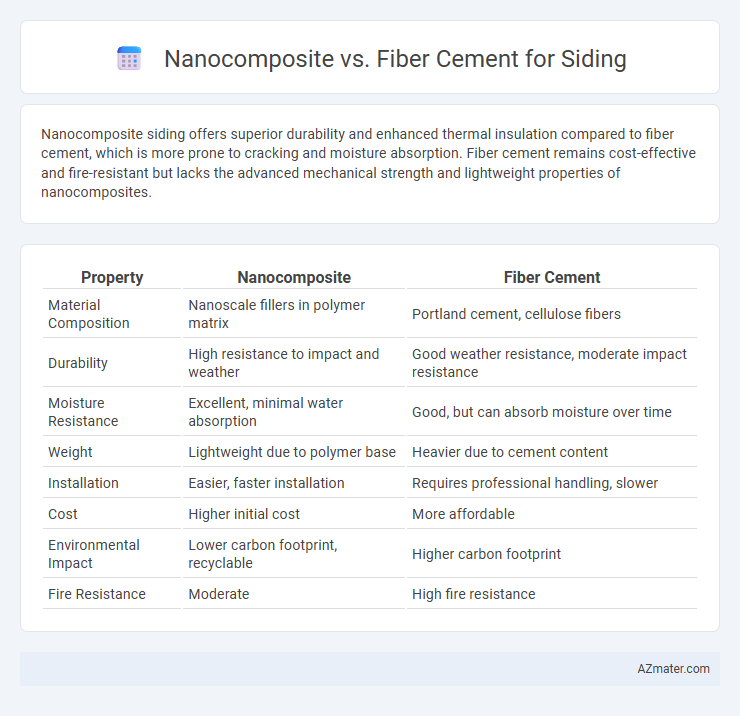Nanocomposite siding offers superior durability and enhanced thermal insulation compared to fiber cement, which is more prone to cracking and moisture absorption. Fiber cement remains cost-effective and fire-resistant but lacks the advanced mechanical strength and lightweight properties of nanocomposites.
Table of Comparison
| Property | Nanocomposite | Fiber Cement |
|---|---|---|
| Material Composition | Nanoscale fillers in polymer matrix | Portland cement, cellulose fibers |
| Durability | High resistance to impact and weather | Good weather resistance, moderate impact resistance |
| Moisture Resistance | Excellent, minimal water absorption | Good, but can absorb moisture over time |
| Weight | Lightweight due to polymer base | Heavier due to cement content |
| Installation | Easier, faster installation | Requires professional handling, slower |
| Cost | Higher initial cost | More affordable |
| Environmental Impact | Lower carbon footprint, recyclable | Higher carbon footprint |
| Fire Resistance | Moderate | High fire resistance |
Introduction to Siding Materials
Nanocomposite siding offers enhanced durability and resistance to weather, combining nanoparticles with traditional materials to improve strength and longevity. Fiber cement siding, composed of cement, sand, and cellulose fibers, is renowned for its fire resistance, moisture resistance, and low maintenance needs. Both materials provide superior performance compared to traditional wood or vinyl, with nanocomposites delivering advanced technological benefits and fiber cement offering proven reliability.
What Are Nanocomposites?
Nanocomposites are advanced materials engineered by integrating nanoparticles into a matrix, enhancing properties such as strength, durability, and resistance to moisture compared to traditional fiber cement siding. Unlike fiber cement, which combines cement with cellulose fibers, nanocomposites utilize nano-sized fillers like clay, carbon nanotubes, or silica to improve performance at a molecular level. This innovative technology results in siding that offers superior weather resistance, improved thermal insulation, and longer lifespan, making nanocomposites a cutting-edge alternative in exterior cladding materials.
What Is Fiber Cement Siding?
Fiber cement siding is a durable exterior cladding material composed of cement, sand, and cellulose fibers, offering resistance to fire, rot, and pests. It mimics the appearance of wood, stone, or brick while providing enhanced longevity and low maintenance compared to traditional materials. Fiber cement is widely used in residential and commercial buildings for its strength, weather resistance, and ability to withstand harsh environmental conditions.
Durability Comparison: Nanocomposite vs Fiber Cement
Nanocomposite siding offers superior durability compared to fiber cement due to its advanced polymer matrix, which enhances resistance to cracking, moisture, and UV damage. Fiber cement siding, while known for its fire resistance and strength, is more prone to chipping and requires regular maintenance to prevent water infiltration and degradation over time. Nanocomposites maintain structural integrity longer under harsh weather conditions, making them a more resilient choice for long-term exterior applications.
Weather Resistance and Environmental Impact
Nanocomposite siding offers superior weather resistance due to its enhanced durability against moisture, UV rays, and temperature fluctuations, resulting from the integration of nanoparticles that improve structural integrity and prevent degradation. Fiber cement siding also provides strong weather resistance by combining cement, sand, and cellulose fibers to resist rot, fire, and insects, but it may be more susceptible to cracking under extreme weather conditions. Environmentally, nanocomposite materials often use advanced, sustainable components with lower carbon footprints, while fiber cement production involves energy-intensive processes and the use of raw materials that can impact natural resources.
Installation Process and Ease
Nanocomposite siding offers a lightweight design that simplifies handling and speeds up installation compared to fiber cement, which is heavier and more cumbersome to maneuver. The nanocomposite panels often come pre-finished and require fewer tools, reducing labor time, whereas fiber cement demands specialized cutting tools and protective gear due to silica dust. Faster installation with nanocomposites results in lower labor costs and minimal disruption on site, making it a more efficient choice for siding projects.
Cost Analysis and Long-Term Value
Nanocomposite siding typically offers lower initial installation costs compared to fiber cement, as it requires less labor and specialized tools. Fiber cement, while more expensive upfront due to its durability and resistance to weather, provides greater long-term value by reducing maintenance and replacement frequency. Considering lifecycle expenses, fiber cement tends to yield higher return on investment through enhanced performance and longevity in diverse climates.
Design Flexibility and Aesthetic Options
Nanocomposite siding offers enhanced design flexibility with its ability to be molded into intricate shapes and textures, providing a modern, sleek aesthetic that can mimic natural materials like wood or stone. Fiber cement siding provides classic aesthetic options with a variety of textures and finishes, including wood grain and smooth surfaces, but it is generally limited in intricate customization compared to nanocomposites. Both materials deliver durability, but nanocomposites excel in innovative design possibilities and contemporary appearances.
Maintenance Requirements
Nanocomposite siding requires minimal maintenance due to its enhanced durability and resistance to moisture, mold, and insects, reducing the need for frequent painting or sealing. Fiber cement siding, while highly durable and resistant to fire and rot, demands regular repainting and sealing to prevent moisture damage and maintain its appearance. Both materials offer long-lasting siding solutions, but nanocomposites provide a more maintenance-free option suitable for homeowners seeking low upkeep.
Choosing the Best Siding: Key Considerations
Nanocomposite siding offers superior durability, enhanced weather resistance, and lightweight properties compared to fiber cement, which is known for its fire resistance and affordability. When choosing the best siding, consider factors such as climate suitability, maintenance requirements, installation complexity, and long-term cost-effectiveness. Evaluating the thermal insulation and environmental impact of both nanocomposite and fiber cement materials ensures an informed decision tailored to specific residential or commercial needs.

Infographic: Nanocomposite vs Fiber cement for Siding
 azmater.com
azmater.com